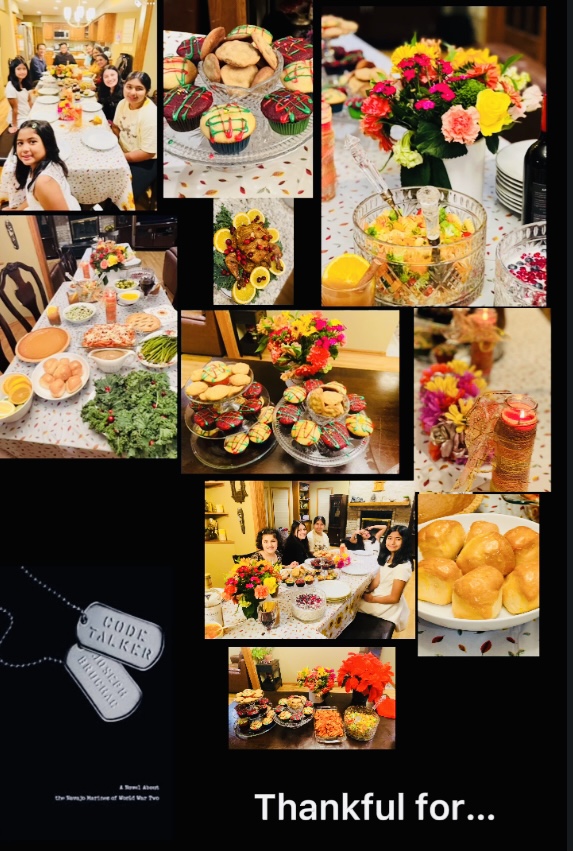Hello Everyone,
Hope you had a great Thanksgiving!
If you remember, last year I had written a blog about Pocahontas for Native American Heritage Month. Native American Heritage Day is normally the day after Thanksgiving. That day also falls on the day everyone is excited about. You guessed it, Black Friday!
Thanksgiving is one of my favorite holidays. For the past few days, we have been planning our menu and inviting a few family friends for our Thanksgiving dinner. The day before Thanksgiving, we were really busy in the kitchen, going from one store to the other and arranging tables. Last year, I baked some treats for dinner and this year I have decided on some cupcakes and cookies along with pasta and a special salad (my recipe). We have planned on having a bit of a Nepali American Thanksgiving. Last year, we tried making American food for Thanksgiving. It went well, so we decided to stick with the same menu. This year I am thankful for my family, my friends who have been by my side, books, technology, the Covid vaccine, a mask, a roof on top of our head, food on the table, teachers, coaches, tests, and quizzes to increase my confidence, and last but not least our family friends.
Well, many people don’t know about Thanksgiving, but it is quite connected to the Native Americans. So here’s a little history lesson by Professor Janavi Wagle (just kidding). Who are Native Americans? Well, the Native Americans were the first ever people to live in the United States (not the Europeans). It was their land until the first settlers arrived and took over their land. But that isn’t why we celebrate Thanksgiving. In the 1620s, the Pilgrims arrived to start a fresh life. They then met the Wampanoag Indians(Native Americans), who helped them through their journey and shared a huge feast with different foods, similar to the foods we eat on Thanksgiving. We celebrate Thanksgiving to say what we are thankful for. Normally for Thanksgiving, we invite friends and family to celebrate and have a nice feast. Nowadays, the food is a little more modernized. Many people in the United States have ancestors who were from Europe who immigrated to the United States years ago. Although they had their own hardships, it’s extremely disappointing that nobody cared about the Native American tribes and just wanted to kick them out. I don’t know anyone who is Native American but I am indeed familiar with the Native American princess Pocahontas, known as the mother of the United States. This year in Social Studies, we learned about the first settlers, and it was pretty interesting to know how they survived. The Native Americans had different tribes similar to how we have states. Each tribe might have different cultures. It was based on where they lived and what tongue they spoke. Today, I will be sharing with you a book that talks about the life of the Navajo tribe in the 1940s.
Code Talker by Joseph Bruchac is one of the books from a book club in my school called the Battle of the Books. I’m halfway through the book and I find the book quite interesting so far. This book is about a boy named Nez (His American name) who grew up in an entire Navajo community. When he got a little older, his family told him he had to go to school to learn English. This book took place in World War II. When he went to an English school filled with other Navajo, they all had to have an American first name and last name. They couldn’t speak their own language and had to only speak English, which was a language they didn’t know. If they were heard speaking Navajo, they would be severely punished. Their long hairs, which were culturally significant, were cut. Despite all the challenges, Nez continued to remember his sacred language and traditions. When Japan attacked Pearl Harbor, America declared war on Japan. Many Native Americans joined the army at that time, including Nez. When he turned 16, he joined the Navy to fight for the country against Japan. I haven’t finished the book but it was interesting to know that the Navajo language had saved the country. The American army used the Navajo language to create codes that the Japanese couldn’t understand. This helped Americans to defeat Japan as the secret codes in Navajo were hard to crack. Navajo language is tonal and unwritten. To learn more about Nez and his life read this book.
If you want to read this book, please check it out at your local library, on Amazon, or get it on sora, where they provide ebooks and audiobooks to all students.
Thank you everyone for reading this blog!
